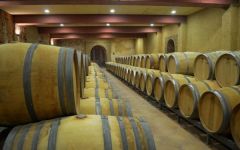Mustiguillo Finca Terrerazo 2016
-
Robert
Parker



Product Details
Your Rating
Somm Note
Winemaker Notes
Pairs well with game meats, T-bone steaks, Castilian Gazpacho.
Professional Ratings
-
Robert Parker's Wine Advocate
I also tasted two vintages from their flagship red that carries the name of their property and single-estate appellation, the oldest of which was the 2016 Finca Terrerazo, which I was able to compare with the 2017. 2016 was a cool vintage that delivered wines with great acidity, a low-yielding year with a dry and healthy harvest. The pure Bobal grapes, from vines at 800 meters in altitude on limestone-rich soils, were planted between 1945 and 1970. The grapes were fermented by plot in 3,500- and 5,000-liter oak vats with indigenous yeasts, and the wine matured in a combination of used 225- and 500-liter French oak barrels and those 3,500-liter oak vats. It has dark berry aromas, spices and a touch of smoke and ash, a little in the old style, something very evident when I tasted this next to the 2017, which felt a lot more elegant and precise. They started working the vineyards differently, but the change in the winery was in 2017. 23,700 bottles produced. It was bottled in May 2018.
Other Vintages
2019-
Robert
Parker - Decanter
- Decanter
-
Robert
Parker
-
Wine
Enthusiast -
Robert
Parker
-
Robert
Parker





A relatively new winery, Mustiguillo was created to give a place and prominence to the unheralded varietal Bobal. The owners believe strongly that this grape, when cropped low and harvested later, can produce wines that rival some of the greatest wines of Northern Spain. As such, many of the old vines of the property have been kept (some as old as 90 years old) and new vines of Bobal have been planted as well.
Utiel-Requena lies on a warm, arid plateau at an average of 700 meters above sea level. Mustiguillo owns four distinct parcels scattered throughout the zone including two over 800 meters. Soil structure is quite poor, with low amounts of organic material. Gravel, some clay, and smaller amounts of limestone make up the bulk of the vineyards. Rainfall is lower than the Spanish average and this shortage is thought to contribute to the excellent fruit concentration of these vines.

Spanish red wine is known for being bold, heady, rustic and age-worthy, Spain is truly a one-of-a-kind wine-producing nation. A great majority of the country is hot, arid and drought-ridden, and since irrigation has only been recently introduced and (controversially) accepted, viticulture has sustained—and flourished—only through a great understanding of Spain’s particular conditions. Large spacing between vines allows each enough resources to survive and as a result, the country has the most acreage under vine compared to any other country, but is usually third in production.
Of the Spanish red wines, the most planted and respected grape variety is Tempranillo, the star of Spain’s Rioja and Ribera del Duero regions. Priorat specializes in bold red blends, Jumilla has gained global recognition for its single varietal Monastrell and Utiel-Requena has garnered recent attention for its reds made of Bobal.
